Jean Cocteau
Jean Maurice Eugène Clément Cocteau (UK: /ˈkɒktoʊ/, US: /kɒkˈtoʊ/, French: [ʒɑ̃ moʁis øʒɛn klemɑ̃ kɔkto]; 5 July 1889 – 11 October 1963) was a French poet, playwright, novelist, designer, filmmaker, visual artist and critic.
Jean Cocteau | |
|---|---|
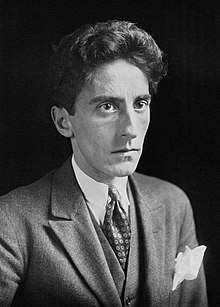 Cocteau in 1923 | |
| Born | Jean Maurice Eugène Clément Cocteau 5 July 1889 Maisons-Laffitte, France |
| Died | 11 October 1963 (aged 74) Milly-la-Foret, France |
| Other names | The Frivolous Prince |
| Occupation |
|
| Years active | 1908–1963 |
| Partner(s) |
|
| Website | jeancocteau |
| Signature | |
 | |
| French literature |
|---|
| by category |
| French literary history |
| French writers |
|
| Portals |
|
Works
Jean Cocteau insisted on calling himself a poet, classifying the great variety of his works – poems, novels, plays, essays, drawings, films – as "poésie", "poésie de roman", "poésie de thêatre", "poésie critique", "poésie graphique" and "poésie cinématographique".[1]
He is best known for his novels Le Grand Écart (1923), Le Livre Blanc (1928), and Les Enfants Terribles (1929); the stage plays La Voix Humaine (1930), La Machine Infernale (1934), Les Parents terribles (1938), La Machine à écrire (1941), and L'Aigle à deux têtes (1946); and the films The Blood of a Poet (1930), Les Parents Terribles (1948), Beauty and the Beast (1946), Orpheus (1949), and Testament of Orpheus (1960), which alongside Blood of a Poet and Orpheus constitute the so-called Orphic Trilogy. He was described as "one of [the] avant-garde's most successful and influential filmmakers" by AllMovie.[2]
Biography
Early life
Cocteau was born in Maisons-Laffitte, Yvelines, a town near Paris, to Georges Cocteau and his wife, Eugénie Lecomte; a socially prominent Parisian family. His father was a lawyer and amateur painter, who committed suicide when Cocteau was nine. From 1900–1904, Cocteau attended the Lycée Condorcet where he met and began a relationship with schoolmate Pierre Dargelos, who would later reappear throughout Cocteau's oeuvre.[3] He left home at fifteen. He published his first volume of poems, Aladdin's Lamp, at nineteen. Cocteau soon became known in Bohemian artistic circles as The Frivolous Prince, the title of a volume he published at twenty-two. Edith Wharton described him as a man "to whom every great line of poetry was a sunrise, every sunset the foundation of the Heavenly City..."[4]
Early career
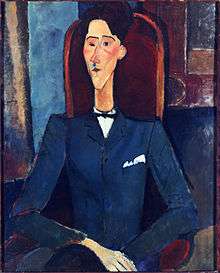
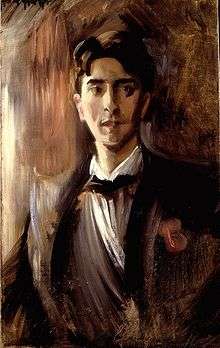
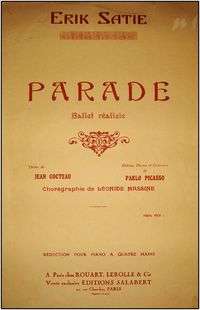
In his early twenties, Cocteau became associated with the writers Marcel Proust, André Gide, and Maurice Barrès. In 1912, he collaborated with Léon Bakst on Le Dieu bleu for the Ballets Russes; the principal dancers being Tamara Karsavina and Vaslav Nijinsky. During World War I Cocteau served in the Red Cross as an ambulance driver. This was the period in which he met the poet Guillaume Apollinaire, artists Pablo Picasso and Amedeo Modigliani, and numerous other writers and artists with whom he later collaborated. Russian impresario Sergei Diaghilev persuaded Cocteau to write a scenario for a ballet, which resulted in Parade in 1917. It was produced by Diaghilev, with sets by Picasso, the libretto by Apollinaire and the music by Erik Satie. The piece was later expanded into a full opera, with music by Satie, Francis Poulenc and Maurice Ravel. "If it had not been for Apollinaire in uniform," wrote Cocteau, "with his skull shaved, the scar on his temple and the bandage around his head, women would have gouged our eyes out with hairpins." He denied being a Surrealist or being in any way attached to the movement.
An important exponent of avant-garde art, Cocteau had great influence on the work of others, including a group of composers known as Les six. In the early twenties, he and other members of Les six frequented a wildly popular bar named Le Boeuf sur le Toit, a name that Cocteau himself had a hand in picking. The popularity was due in no small measure to the presence of Cocteau and his friends.[5]
Friendship with Raymond Radiguet

In 1918 he met the French poet Raymond Radiguet. They collaborated extensively, socialized, and undertook many journeys and vacations together. Cocteau also got Radiguet exempted from military service. Admiring of Radiguet's great literary talent, Cocteau promoted his friend's works in his artistic circle and arranged for the publication by Grasset of Le Diable au corps (a largely autobiographical story of an adulterous relationship between a married woman and a younger man), exerting his influence to have the novel awarded the "Nouveau Monde" literary prize. Some contemporaries and later commentators thought there might have been a romantic component to their friendship.[6] Cocteau himself was aware of this perception, and worked earnestly to dispel the notion that their relationship was sexual in nature.[7]
There is disagreement over Cocteau's reaction to Radiguet's sudden death in 1923, with some claiming that it left him stunned, despondent and prey to opium addiction. Opponents of that interpretation point out that he did not attend the funeral (he generally did not attend funerals) and immediately left Paris with Diaghilev for a performance of Les noces (The Wedding) by the Ballets Russes at Monte Carlo. Cocteau himself much later characterised his reaction as one of "stupor and disgust." His opium addiction at the time,[8] Cocteau said, was only coincidental, due to a chance meeting with Louis Laloy, the administrator of the Monte Carlo Opera. Cocteau's opium use and his efforts to stop profoundly changed his literary style. His most notable book, Les Enfants Terribles, was written in a week during a strenuous opium weaning. In Opium: Journal of drug rehabilitation, he recounts the experience of his recovery from opium addiction in 1929. His account, which includes vivid pen-and-ink illustrations, alternates between his moment-to-moment experiences of drug withdrawal and his current thoughts about people and events in his world. Cocteau was supported throughout his recovery by his friend and correspondent, Catholic philosopher Jacques Maritain. Under Maritain's influence Cocteau made a temporary return to the sacraments of the Catholic Church. He again returned to the Church later in life and undertook a number of religious art projects.
Further works
On June 15, 1926 Cocteau's play Orphée was staged in Paris. It was quickly followed by an exhibition of drawings and "constructions" called Poésie plastique–objets, dessins. Cocteau wrote the libretto for Igor Stravinsky's opera-oratorio Oedipus rex, which had its original performance in the Théâtre Sarah Bernhardt in Paris on 30 May 1927. In 1929 one of his most celebrated and well known works, the novel Les Enfants terribles was published.[1]
In 1930 Cocteau made his first film The Blood of a Poet, publicly shown in 1932. Though now generally accepted as a surrealist film, the surrealists themselves did not accept it as a truly surrealist work. Although one of Cocteau's best known works the 1930's is notable rather for a number of stage plays. Most notably La Voix humaine and Les Parents terribles, which was a popular success. His 1934 play La Machine infernal was Cocteau's stage version of the Oedipus legend and is considered to be his greatest work for the theater.[9] During this period Cocteau also published two volumes of journalism, including Mon Premier Voyage: Tour du Monde en 80 jours, a neo-Jules Verne around the world travel reportage he made for the newspaper Paris-Soir.[1]
1940–1944
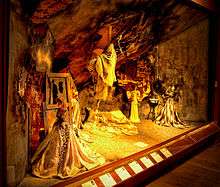
Biographer James S. Williams describes Cocteau's politics as "naturally Right-leaning."[10] During the Nazi occupation of France, he was in a "round-table" of French and German intellectuals who met at the Georges V Hotel in Paris, including Cocteau, the writers Ernst Junger, Paul Morand and Henry Millon de Montherlant, the publisher Gaston Gallimard and the Nazi legal scholar Carl Schmitt.[11]
His friend Arno Breker convinced him that Adolf Hitler was a pacifist and patron of the arts with France's best interests in mind. In his diary, Cocteau accused France of disrespect towards Hitler and speculated on the Führer's sexuality. Cocteau effusively praised Breker's sculptures in an article entitled 'Salut à Breker' published in 1942. This piece caused him to be arraigned on charges of collaboration after the war, though he was cleared of any wrongdoing and had used his contacts to his failed attempt to save friends such as Max Jacob.[12]
In 1940, Le Bel Indifférent, Cocteau's play written for and starring Édith Piaf, was enormously successful.
Later years
Cocteau's later years is mostly associated with his films. Cocteau's films, most of which he both wrote and directed, were particularly important in introducing the avant-garde into French cinema and influenced to a certain degree the upcoming French New Wave genre.[2]
Following The Blood of a Poet (1930), his best known films include Beauty and the Beast (1946), Les Parents terribles (1948), and Orpheus (1949). His final film, Le Testament d'Orphée (The Testament of Orpheus) (1960), featured appearances by Picasso and matador Luis Miguel Dominguín, along with Yul Brynner, who also helped finance the film.
In 1945 Cocteau was one of several designers who created sets for the Théâtre de la Mode. He drew inspiration from filmmaker René Clair while making Tribute to René Clair: I Married a Witch. The maquette is described in his "Journal 1942–1945," in his entry for 12 February 1945:
I saw the model of my set. Fashion bores me, but I am amused by the set and fashion placed together. It is a smoldering maid's room. One discovers an aerial view of Paris through the wall and ceiling holes. It creates vertigo. On the iron bed lies a fainted bride. Behind her stand several dismayed ladies. On the right, a very elegant lady washes her hands in a flophouse basin. Through the unhinged door on the left, a lady enters with raised arms. Others are pushed against the walls. The vision provoking this catastrophe is a bride-witch astride a broom, flying through the ceiling, her hair and train streaming.
In 1956 Cocteau decorated the Chapelle Saint-Pierre in Villefranche-sur-Mer with mural paintings. The following year he also decorated the marriage hall at the Hôtel de Ville in Menton.[13]
Private life
Jean Cocteau never hid his homosexuality. He was the author of the mildly homoerotic and semi-autobiographical Le livre blanc (translated as The White Paper or The White Book),[14] published anonymously in 1928. He never repudiated its authorship and a later edition of the novel features his foreword and drawings. The novel begins:
As far back as I can remember, and even at an age when the mind does not yet influence the senses, I find traces of my love of boys. I have always loved the strong sex that I find legitimate to call the fair sex. My misfortunes came from a society that condemns the rare as a crime and forces us to reform our inclinations.
Frequently his work, either literary (Les enfants terribles), graphic (erotic drawings, book illustration, paintings) or cinematographic (The Blood of a Poet, Orpheus, Beauty and the Beast), is pervaded with homosexual undertones, homoerotic imagery/symbolism or outright camp. In 1947 Paul Morihien published a clandestine edition of Querelle de Brest by Jean Genet, featuring 29 very explicit erotic drawings by Cocteau. In recent years several albums of Cocteau's homoerotica have been available to the general public.
It is widely believed that Cocteau had affairs with Raymond Radiguet,[15] Jean Desbordes,[16] Marcel Khill,[17] and Panama Al Brown.[18]
In the 1930s, Cocteau is rumoured to have had a very brief affair with Princess Natalie Paley, the daughter of a Romanov Grand Duke and herself a sometime actress, model, and former wife of couturier Lucien Lelong.[19]
Cocteau's longest-lasting relationships were with French actors Jean Marais[20] and Édouard Dermit, whom Cocteau formally adopted. Cocteau cast Marais in The Eternal Return (1943), Beauty and the Beast (1946), Ruy Blas (1947), and Orpheus (1949).
Death
Cocteau died of a heart attack at his château in Milly-la-Forêt, Essonne, France, on 11 October 1963 at the age of 74. His friend, French singer Édith Piaf, died the day before but that was announced on the morning of Cocteau's day of death; it has been said that his heart failed upon hearing of Piaf's death. Actually, according to author Roger Peyrefitte,[21] since early that year Cocteau had been devastated after a breach with his longtime friend and extremely wealthy and generous patroness Francine Weisweiller: since 1960 she was having an affair with a minor writer, which cooled her off towards Cocteau.[22] He had a very severe heart attack on April 22.
According to his wishes Cocteau is buried beneath the floor of the Chapelle Saint-Blaise des Simples in Milly-la-Forêt.[23] The epitaph on his gravestone set in the floor of the chapel reads: "I stay with you" ("Je reste avec vous").
Honours and awards
In 1955, Cocteau was made a member of the Académie française and The Royal Academy of Belgium.
During his life, Cocteau was commander of the Legion of Honor, Member of the Mallarmé Academy, German Academy (Berlin), American Academy, Mark Twain (U.S.A) Academy, Honorary President of the Cannes Film Festival, Honorary President of the France-Hungary Association and President of the Jazz Academy and of the Academy of the Disc.
Filmography
| Year | Original title | English title |
|---|---|---|
| 1930 | Le Sang d'un poète | The Blood of a Poet |
| 1946 | La Belle et la Bête | The Beauty and the Beast |
| 1948 | L'Aigle à deux têtes | The Eagle with Two Heads |
| Les Parents terribles | The Terrible Parents, a.k.a. The Storm Within | |
| 1950 | Orphée | Orpheus |
| 1957 | 8 × 8: A Chess Sonata in 8 Movements | N/A |
| 1960 | Le Testament d'Orphée | The Testament of Orpheus |
Works
Literature
- Poetry
- 1909: La Lampe d'Aladin
- 1910: Le Prince frivole
- 1912: La Danse de Sophocle
- 1919: Ode à Picasso – Le Cap de Bonne-Espérance
- 1920: Escale. Poésies (1917–1920)
- 1922: Vocabulaire
- 1923: La Rose de François – Plain-Chant
- 1925: Cri écrit
- 1926: L'Ange Heurtebise
- 1927: Opéra
- 1934: Mythologie
- 1939: Énigmes
- 1941: Allégories
- 1945: Léone
- 1946: La Crucifixion
- 1948: Poèmes
- 1952: Le Chiffre sept – La Nappe du Catalan (in collaboration with Georges Hugnet)
- 1953: Dentelles d'éternité – Appoggiatures
- 1954: Clair-obscur
- 1958: Paraprosodies
- 1961: Cérémonial espagnol du Phénix – La Partie d'échecs
- 1962: Le Requiem
- 1968: Faire-Part (posthume)
- Novels
- 1919: Le Potomak (definitive edition: 1924)
- 1923: Le Grand Écart – Thomas l'imposteur
- 1928: Le Livre blanc
- 1929: Les Enfants terribles
- 1940: La Fin du Potomak
- Theater
- 1917: Parade, ballet (music by Erik Satie, choreography by Léonide Massine)
- 1921: Les mariés de la tour Eiffel, ballet (music by Georges Auric, Arthur Honegger, Darius Milhaud, Francis Poulenc and Germaine Tailleferre)
- 1922: Antigone
- 1924: Roméo et Juliette
- 1925: Orphée
- 1927: Oedipus Rex, opera-oratorio (music by Igor Stravinsky)
- 1930: La Voix humaine
- 1934: La Machine infernale
- 1936: L'École des veuves
- 1937: Œdipe-roi. Les Chevaliers de la Table ronde, premiere at the Théâtre Antoine
- 1938: Les Parents terribles, premiere at the Théâtre Antoine
- 1940: Les Monstres sacrés
- 1941: La Machine à écrire
- 1943: Renaud et Armide. L'Épouse injustement soupçonnée
- 1944: L'Aigle à deux têtes
- 1946: Le Jeune Homme et la Mort, ballet by Roland Petit
- 1948: Théâtre I and II
- 1951: Bacchus
- 1960: Nouveau théâtre de poche
- 1962: L'Impromptu du Palais-Royal
- 1971: Le Gendarme incompris (in collaboration with Raymond Radiguet and Francis Poulenc)
- Poetry and criticism
- 1918: Le Coq et l'Arlequin
- 1920: Carte blanche
- 1922: Le Secret professionnel
- 1926: Le Rappel à l'ordre – Lettre à Jacques Maritain – Le Numéro Barbette
- 1930: Opium
- 1932: Essai de critique indirecte
- 1935: Portraits-Souvenir
- 1937: Mon premier voyage (Around the World in 80 Days)
- 1943: Le Greco
- 1947: Le Foyer des artistes – La Difficulté d'être
- 1949: Lettres aux Américains – Reines de la France
- 1951: Jean Marais – A Discussion about Cinematography (with André Fraigneau)
- 1952: Gide vivant
- 1953: Journal d'un inconnu. Démarche d'un poète
- 1955: Colette (Discourse on the reception at the Royal Academy of Belgium) – Discourse on the reception at the Académie française
- 1956: Discours d'Oxford
- 1957: Entretiens sur le musée de Dresde (with Louis Aragon) – La Corrida du 1er mai
- 1950: Poésie critique I
- 1960: Poésie critique II
- 1962: Le Cordon ombilical
- 1963: La Comtesse de Noailles, oui et non
- 1964: Portraits-Souvenir (posthumous; A discussion with Roger Stéphane)
- 1965: Entretiens avec André Fraigneau (posthumous)
- 1973: Jean Cocteau par Jean Cocteau (posthumous; A discussion with William Fielfield)
- 1973: Du cinématographe (posthumous). Entretiens sur le cinématographe (posthumous)
- Journalistic poetry
- 1935–1938 (posthumous)
Film
- Director
- 1925: Jean Cocteau fait du cinéma lost[24]
- 1930: Le Sang d'un poète
- 1946: La Belle et la Bête
- 1948: L'Aigle à deux têtes
- 1948: Les Parents terribles
- 1950: Orphée
- 1950: Coriolan unreleased home movie[25]
- 1952: La Villa Santo-Sospir
- 1955: L'Amour sous l'électrode
- 1957: 8 × 8: A Chess Sonata in 8 Movements
- 1960: Le Testament d'Orphée
- Scriptwriter
- 1943: L'Éternel Retour directed by Jean Delannoy
- 1944: Les Dames du Bois de Boulogne directed by Robert Bresson
- 1948: Ruy Blas directed by Pierre Billon
- 1950: Les Enfants terribles directed by Jean-Pierre Melville, script by Jean Cocteau based on his novel
- 1951: La Couronne Noire directed by Luis Saslavsky
- 1961: La Princesse de Clèves directed by Jean Delannoy
- 1965: Thomas l'imposteur directed by Georges Franju, script by Jean Cocteau based on his novel
- Dialogue writer
- 1943: Le Baron fantôme (+ actor) directed by Serge de Poligny
- 1961: La Princesse de Clèves directed by Jean Delannoy
- 1965: Thomas l'imposteur directed by Georges Franju
- Director of Photography
- 1950: Un chant d'amour réalisé par Jean Genet
Artworks
- 1924 : Dessins
- 1925 : Le Mystère de Jean l'oiseleur
- 1926 : Maison de santé
- 1929 : 25 dessins d'un dormeur
- 1935 : 60 designs for Les Enfants Terribles
- 1941 : Drawings in the margins of Chevaliers de la Table ronde
- 1948 : Drôle de ménage
- 1957 : La Chapelle Saint-Pierre, Villefranche-sur-Mer
- 1958 : La Salle des mariages, City Hall of Menton – La Chapelle Saint-Pierre (lithographies)
- 1959 : Gondol des morts
- 1960 : Chapelle Saint-Blaise-des-Simples, Milly-la-Forêt
- 1960 : Stained glass windows of the Church of Saint Maximin, Metz, France[26]
Recordings
- Colette par Jean Cocteau, discours de réception à l'Académie Royale de Belgique, Ducretet-Thomson 300 V 078 St.
- Les Mariés de la Tour Eiffel and Portraits-Souvenir, La Voix de l'Auteur LVA 13
- Plain-chant by Jean Marais, extracts from the piece Orphée by Jean-Pierre Aumont, Michel Bouquet, Monique Mélinand, Les Parents terribles by Yvonne de Bray and Jean Marais, L'Aigle à deux têtes par Edwige Feuillère and Jean Marais, L'Encyclopédie Sonore 320 E 874, 1971
- Collection of three vinyl recordings of Jean Cocteau including La Voix humaine by Simone Signoret, 18 songs composed by Louis Bessières, Bee Michelin and Renaud Marx, on double-piano Paul Castanier, Le Discours de réception à l'Académie française, Jacques Canetti JC1, 1984
- Derniers propos à bâtons rompus avec Jean Cocteau, 16 September 1963 à Milly-la-Forêt, Bel Air 311035
- Les Enfants terribles, radio version with Jean Marais, Josette Day, Silvia Monfort and Jean Cocteau, CD Phonurgia Nova ISBN 2-908325-07-1, 1992
- Anthology, 4 CD containing numerous poems and texts read by the author, Anna la bonne, La Dame de Monte-Carlo and Mes sœurs, n'aimez pas les marins by Marianne Oswald, Le Bel Indifférent by Edith Piaf, La Voix humaine by Berthe Bovy, Les Mariés de la Tour Eiffel with Jean Le Poulain, Jacques Charon and Jean Cocteau, discourse on the reception at the Académie française, with extracts from Les Parents terribles, La Machine infernale, pieces from Parade on piano with two hands by Georges Auric and Francis Poulenc, Frémeaux & Associés FA 064, 1997
- Poems by Jean Cocteau read by the author, CD EMI 8551082, 1997
- Hommage à Jean Cocteau, mélodies d'Henri Sauguet, Arthur Honegger, Louis Durey, Darius Milhaud, Erik Satie, Jean Wiener, Max Jacob, Francis Poulenc, Maurice Delage, Georges Auric, Guy Sacre, by Jean-François Gardeil (baritone) and Billy Eidi (piano), CD Adda 581177, 1989
- Le Testament d'Orphée, journal sonore, by Roger Pillaudin, 2 CD INA / Radio France 211788, 1998
Journals
- 1946 La Belle et la Bête (film journal)
- 1949 Maalesh (journal of a stage production)
- 1983 Le Passé défini (posthumous)
- 1989 Journal, 1942–1945
Stamps
- Marianne de Cocteau, 1960
Bibliography
- Cocteau, Jean, Le Coq et l'Arlequin: notes autour de la musique – avec un portrait de l'auteur et deux monogrammes par P. Picasso, Paris, Éditions de la Sirène, 1918
- Cocteau, Jean, Le Grand Écart, 1923, his first novel
- Cocteau, Jean, Le Numéro Barbette, an influential essay on the nature of art inspired by the performer Barbette, 1926
- Cocteau, Jean, The Human Voice, translated by Carl Wildman, Vision Press Ltd., Great Britain, 1947
- Cocteau, Jean, The Eagle Has Two Heads, adapted by Ronald Duncan, Vision Press Ltd., Great Britain, 1947
- Cocteau, Jean, "Bacchus". Paris: Gallimard, 1952.
- Cocteau, Jean, The Holy Terrors (Les Enfants Terribles), translated by Rosamond Lehmann, New Directions. New York, 1957
- Cocteau, Jean, Opium: The Diary of a Cure, translated by Margaret Crosland and Sinclair Road, Grove Press Inc., New York, 1958
- Cocteau, Jean, The Infernal Machine And Other Plays, translated by W.H. Auden, E.E. Cummings, Dudley Fitts, Albert Bermel, Mary C. Hoeck, and John K. Savacool, New Directions Books, New York, 1963
- Cocteau, Jean, Toros Muertos, along with Lucien Clergue and Jean Petit, Brussel & Brussel,1966
- Cocteau, Jean, The Art of Cinema, edited by André Bernard and Claude Gauteur, translated by Robin Buss, Marion Boyars, London, 1988
- Cocteau, Jean, Diary of an Unknown, translated by Jesse Browner, Paragon House Publishers, New York, 1988
- Cocteau, Jean, The White Book (Le Livre blanc), sometimes translated as The White Paper, translated by Margaret Crosland, City Lights Books, San Francisco, 1989
- Cocteau, Jean, Les Parents terribles, new translation by Jeremy Sams, Nick Hern Books, London, 1994
See also
- Jean Cocteau Repertory
- List of ambulance drivers during World War I
- List of people whose parent committed suicide
Footnotes
- Francis Steegmuller "Jean Cocteau: A Brief Biography", Jean Cocteau and the French Scene, Abbeville Press 1984
- "Biography". AllMovie.
- Guédras, Annie, ed. (1999). Jean Cocteau: Erotic Drawings. Köln: Evergreen. p. 11. ISBN 3-8228-6532-X.
- Wharton, Edith (17 December 2014) [1st pub. 1934]. "Chapter 11". A Backward Glance. eBooks@Adelaide. Archived from the original on 29 August 2017. Retrieved 9 April 2016.
- Thompson, Daniella (6 May 2002). "How the Ox got its name, and other Parisian legends". The Boeuf Chronicles. Musica Brasiliensis. Retrieved 9 April 2016. (Autoplaying music on site)
- Williams 2008, p. 32.
- Francis Steegmuller (1970). Cocteau, A Biography.
Monsieur, I have just received your letter and must reply despite my regret at being unable to explain the inexplicable. It is possible that my friendship for your son and my deep admiration for his gifts (which are becoming increasingly apparent) are of an uncommon intensity, and that from the outside it is hard to make out how far my feelings go. His literary future is of primary consideration with me: he is a kind of prodigy. Scandal would spoil all this freshness. You cannot possibly believe for a second that I do not try to avoid that by all the means in my power
- "Jean Cocteau Biography – Jean Cocteau Website". Netcomuk.co.uk. 11 October 1963. Retrieved 14 March 2012.
- Neal Oxenhandler "The Theater of Jean Cocteau", Jean Cocteau and the French scene, Abbeville Press 1984
- Williams 2008, p. 123.
- Junger, Ernst (2019). A German Officer in Occupied Paris. New York: Columbia University Press. p. xvi. ISBN 9780231127400.
- Williams 2008, pp. 182–185.
- Jean Cocteau and the French scene, Abbeville Press 1984, p. 227
- "Cocteau's White Paper on Homophobia". rictornorton.co.uk.
- "Raymond Radiguet". New York Review Books. Retrieved 23 December 2019.
- "Le livre blanc | Koninklijke Bibliotheek". www.kb.nl. Retrieved 23 December 2019.
- "Cocteau". cocteau.biu-montpellier.fr. Retrieved 23 December 2019.
- "The Secret Story of the Groundbreaking Boxing Champ Who Lost His Title -- Because He Was Gay". Narratively. 15 June 2017. Retrieved 23 December 2019.
- Liaut, Jean-Noël (1996). Natalie Paley: Une princesse dechiree (in French). Paris: Filipacchi. ISBN 2-85018-295-8.
- "Légendes d'Écran Noir: Jean Marais". www.ecrannoir.fr.
- Propos secrets, Paris: Albin Michel, 1977
- Francine Weisweiller obituary
- Wilson, Scott. Resting Places: The Burial Sites of More Than 14,000 Famous Persons, 3d ed.: 2 (Kindle Location 8971). McFarland & Company, Inc., Publishers. Kindle Edition.
- Arnaud, Claude (2016). Jean Cocteau: A Life. Yale University Press. pp. 513–. ISBN 978-0-300-17057-3.
- Coriolan, retrieved 31 August 2019
- fr:Église Saint-Maximin de Metz
References
- Breton, André (1953). La Clé des champs, p. 77. Paris: Éditions du Sagittaire.
- Crucifixion translated into Bengali by Malay Roy Choudhury
- Steegmuller, Francis (1970). Cocteau: A Biography. Boston: Atlantic-Little Brown & Company. ISBN 0-316-81219-6.
- Williams, James S. (2008). Jean Cocteau. London: Reaktion. ISBN 978-1861893543.CS1 maint: ref=harv (link)
Further reading
- Evans, Arthur B. (1977). Jean Cocteau and his Films of Orphic Identity. Philadelphia: Art Alliance Press. ISBN 9780879820114.
- Peters, Arthur King. (1986) Jean Cocteau and His World. New York: Vendôme Press. ISBN 0865650683
- Tsakiridou, Cornelia A., ed. (1997). Reviewing Orpheus: Essays on the Cinema and Art of Jean Cocteau. Lewisburg, Pa.: Bucknell University Press. ISBN 0-8387-5379-5.
- Album Cocteau. Biographie et iconographie de Pierre Bergé. Bibliothèque de la Pléiade. Éditions Gallimard, 2006. ISBN 2070118088.
External links
| Wikimedia Commons has media related to Jean Cocteau. |
| Wikiquote has quotations related to: Jean Cocteau |
- Jean Cocteau at the Internet Broadway Database

- Jean Cocteau on IMDb
- Works by or about Jean Cocteau at Internet Archive
- Works by Jean Cocteau at LibriVox (public domain audiobooks)

- Cocteau/cinema Bibliography (via UC Berkeley)
- Jean Cocteau at Curlie
- Cocteau CMEF Cap d'Ail
- Cocteau et La chapelle Saint-Blaise-des-Simples
- Raquel Bitton: The Sparrow and the Birdman, a drama focusing on the relationship of Cocteau to Edith Piaf
- William Fifield (Summer–Fall 1964). "Jean Cocteau, The Art of Fiction No. 34". Paris Review.
- Maison Jean Cocteau - Cocteau's former home